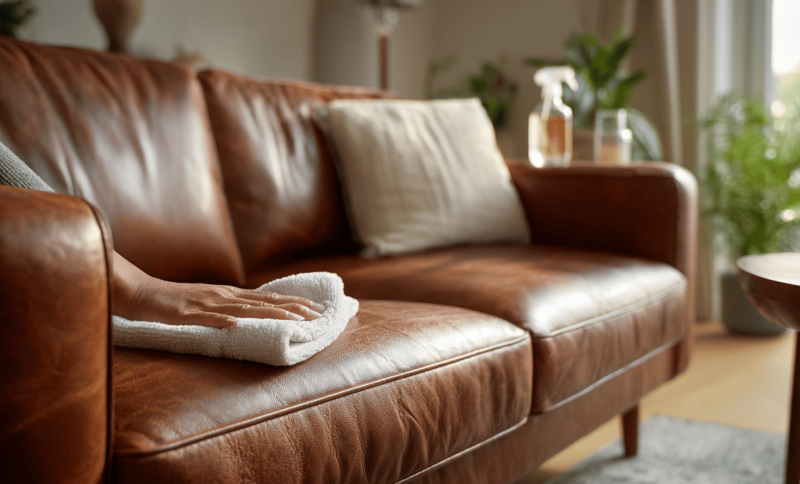Your leather sofa probably cost a pretty penny. Maybe you saved up for months, or it was a special gift.
Either way, you want it to last. But here’s the thing: spills happen. Pets jump on furniture. Kids eat snacks while watching TV. Before you know it, your beautiful leather couch looks dull and dirty.
The good news? Cleaning leather isn’t as scary as it seems. You don’t need expensive professional services or fancy equipment.
With the right approach, you can keep your sofa looking fantastic for years.
You’ll learn which products work best, how to tackle tough stains, and the mistakes that could damage your investment. Let’s get your leather sofa back to its former glory.
How Often Should You Clean Your Leather Sofa?
You don’t need to deep-clean your leather sofa every week. In fact, cleaning it too often can actually cause damage.
For regular maintenance, dust or vacuum your sofa weekly. Use a soft brush attachment to get crumbs and dirt out of the crevices. Wipe it down with a dry microfiber cloth every couple of weeks.
A light cleaning with a damp cloth works well once a month if your sofa gets heavy use. Families with kids or pets might need to do this more often.
Deep cleaning with leather cleaner should happen just once or twice a year. More frequent deep cleaning can dry out the leather and cause cracks.
The key is consistency with light cleaning. This prevents dirt from building up and keeps your sofa looking good between deep cleans.
Materials Required
Gathering your supplies before you start makes the job easier. Here’s everything you need:
| Category | Item | Recommended Products |
|---|---|---|
| Basic Tools | Soft microfiber cloths (multiple) | Any high-quality microfiber cloths |
| Vacuum with brush attachment | Your regular vacuum | |
| Soft-bristle brush | Detailing brush or soft toothbrush | |
| Spray bottle | Any clean spray bottle | |
| Cotton swabs/pads | Standard cotton swabs | |
| Cleaning Products | pH-balanced leather cleaner | Leather Honey Leather Cleaner, Lexol Leather Cleaner, TriNova Leather Cleaner, Chemical Guys Leather Cleaner, Weiman Leather Cleaner |
| Mild dish soap (optional) | Dawn, Seventh Generation (just a few drops) | |
| Distilled water | Any distilled water | |
| Conditioning Products | Leather conditioner | Bickmore Bick 4, Lexol Conditioner, Chemical Guys Leather Conditioner, TriNova Leather Conditioner |
| Stain Removal Items | Cornstarch or baking soda | Any brand |
| Rubbing alcohol (70% isopropyl) | Any pharmacy brand | |
| Testing Supplies | Masking tape | Any masking tape |
Important note: Always test any product on a hidden area first. Wait at least an hour to make sure it doesn’t change the color or texture of your leather.
Step-by-Step: How to Clean Your Leather Sofa
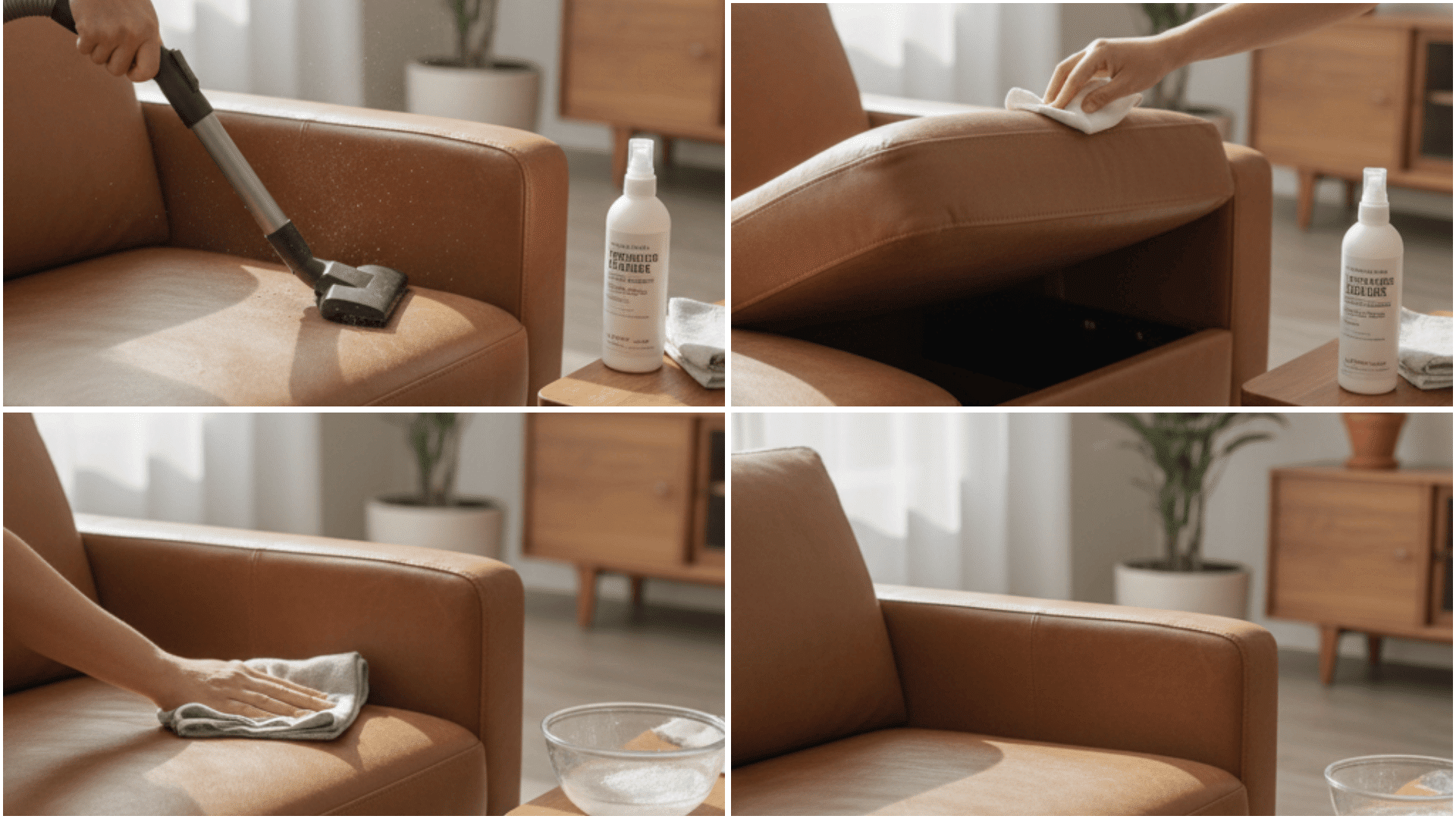
Now let’s get to the actual cleaning process. Take your time and work carefully.
- Step 1: Remove loose dirt and dust. Vacuum your entire sofa using the soft brush attachment. Pay special attention to crevices where crumbs hide. Wipe everything down with a dry microfiber cloth.
- Step 2: Test your cleaner. Find a spot nobody will see, like under a cushion or on the back. Apply a small amount of your chosen cleaner. Wait for an hour and check for any discoloration or damage.
- Step 3: Mix your cleaning solution. If you’re using a commercial cleaner, follow the directions on the bottle. For a DIY solution, add just a few drops of mild soap to a cup of distilled water. The cloth should be damp, not dripping wet.
- Step 4: Clean section by section. Dip your cloth in the cleaning solution and wring it out well. Wipe one section of the sofa at a time using gentle circular motions. Don’t scrub hard or press too firmly. Work from top to bottom so dirty water doesn’t drip on clean areas.
- Step 5: Remove soap residue. Dampen a fresh cloth with plain distilled water. Wipe down each section you just cleaned. This step is important because soap left on leather can cause damage over time.
- Step 6: Dry thoroughly. Use a clean, dry microfiber cloth to buff the leather. This removes excess moisture and brings back some shine.
- Step 7: Let it air dry. Keep your sofa away from direct sunlight, heaters, and fans. Let it dry naturally for several hours. Rushing this step can cause cracks or warping.
Tackling Common Stains on Leather
Different stains need different approaches. Here’s how to handle the most common problems:
1. Water Spills
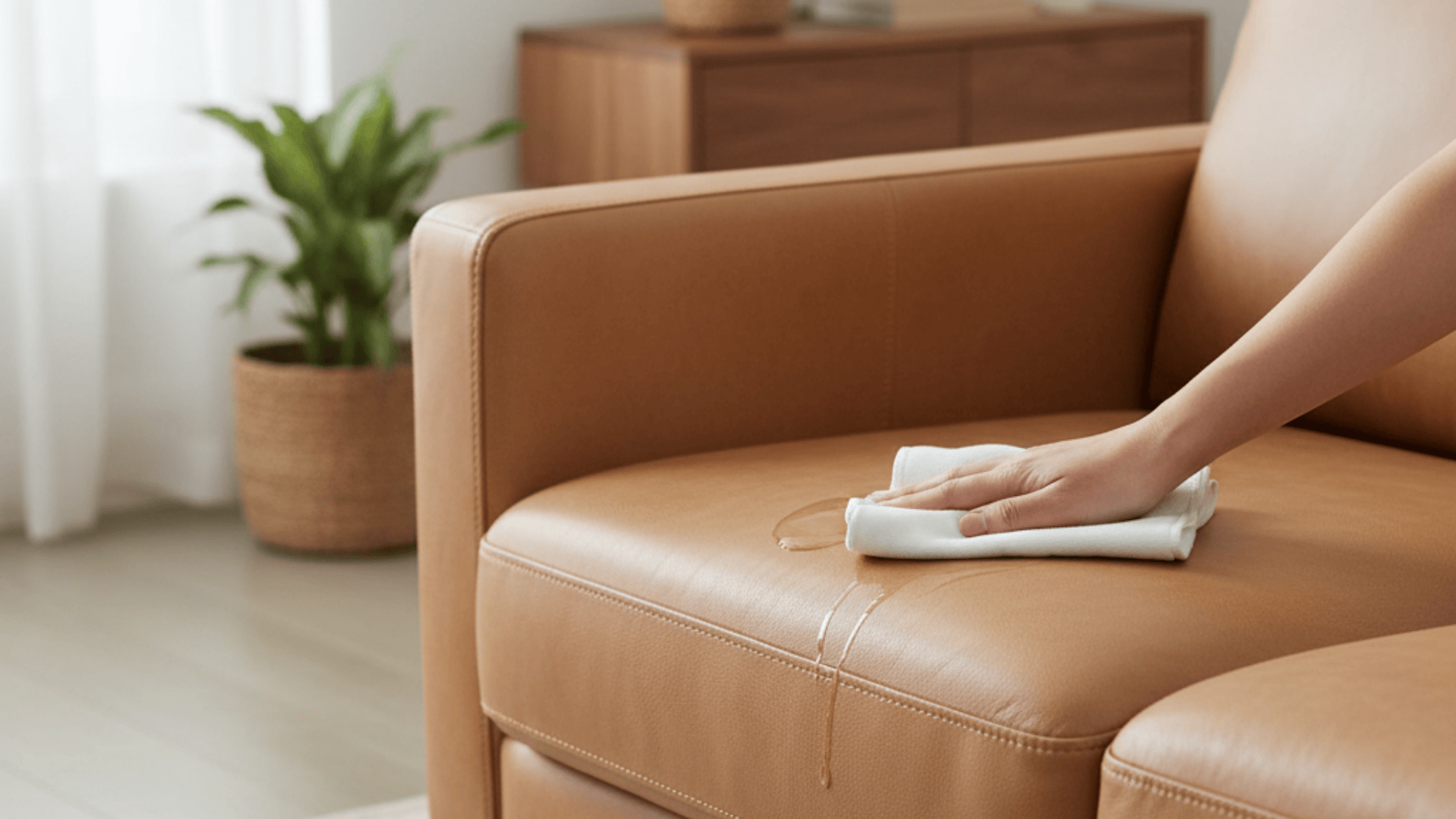
The easiest stain to fix is one that you act on quickly.
- Immediate action: Blot with a dry cloth, never rub
- Drying process: Let the leather air dry naturally, away from heat
- Expected result: Most watermarks disappear completely as they dry
2. Grease or Oil Stains
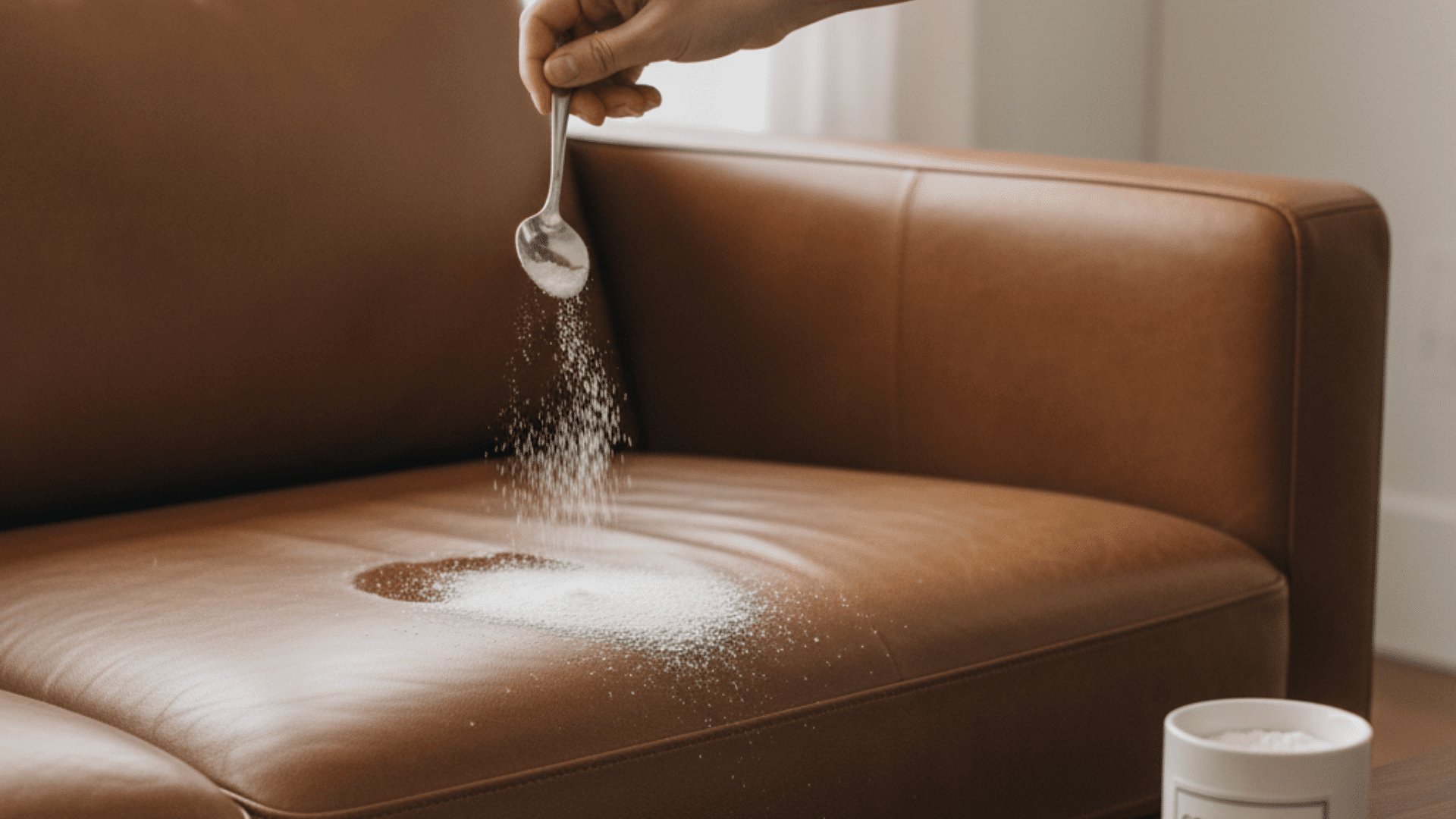
These need an absorbent powder to pull out the oil.
- First step: Sprinkle cornstarch or baking soda directly on the stain
- Waiting time: Leave it for several hours to absorb the oil
- Finishing touch: Brush off gently, then use leather cleaner if needed
3. Ink Marks
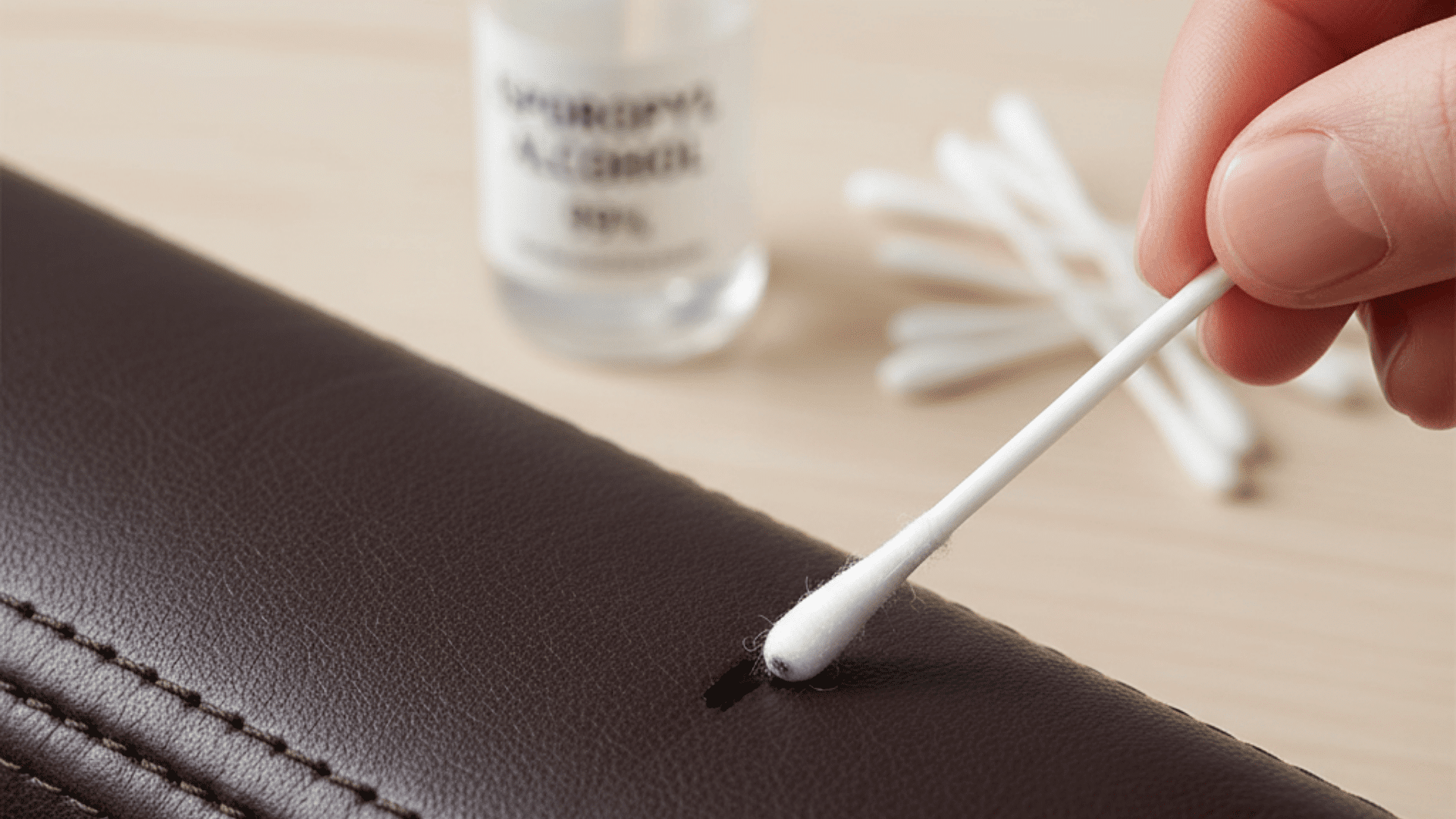
Handle these carefully since alcohol can affect some leather finishes.
- Testing first: Always test rubbing alcohol on a hidden spot
- Application method: Dab a cotton swab in alcohol and touch it to the ink
- Technique: Let the ink transfer to the swab without rubbing
4. Food and Drink Stains
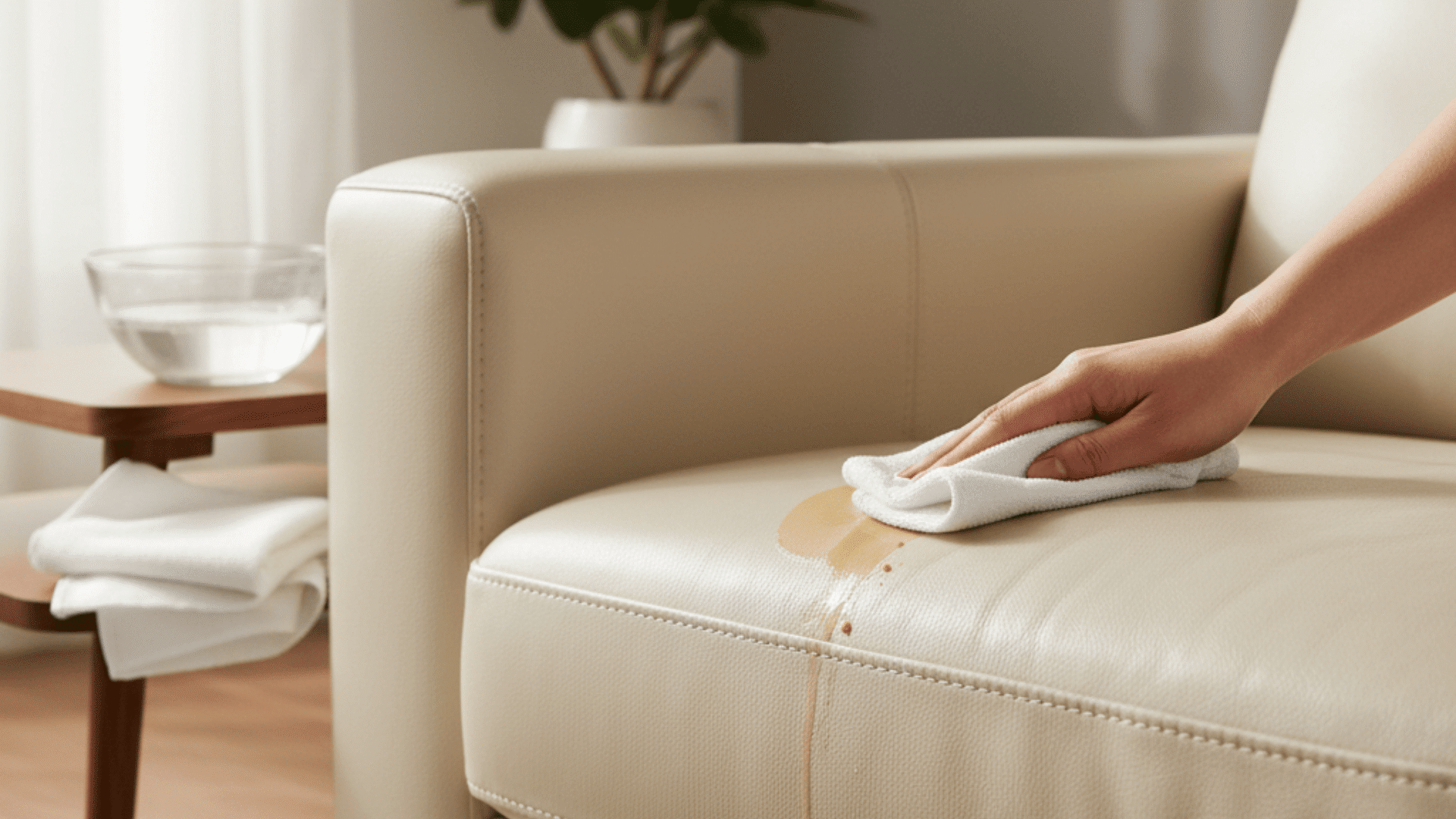
Quick action prevents these from setting permanently.
- Speed matters: Blot up as much as possible right away
- Cleaning solution: Use a damp cloth with a mild soap solution
- Important tip: Avoid colored cleaners that might add new stains
The golden rule for all stains: act fast and blot rather than rub. Most stains come out easily when you catch them early.
Conditioning Your Leather Sofa
Cleaning removes dirt, but it also strips away natural oils from the leather. That’s where conditioning comes in.
Leather conditioner works like a moisturizer for your skin. It replaces lost oils and keeps the material soft and flexible.
Without regular conditioning, leather becomes dry, stiff, and prone to cracking.
Apply conditioner every three to six months, or right after each deep cleaning. Use a small amount on a soft cloth and work it into the leather with circular motions.
Let it soak in for about 15 minutes, then buff off any excess.
Don’t overdo it. Too much conditioner can make the leather sticky or attract more dirt.
Mistakes to Avoid When Cleaning Leather
Some cleaning methods that seem logical can actually ruin your sofa. Here’s what to avoid:
- Don’t use harsh chemicals. Bleach, ammonia, and strong all-purpose cleaners will dry out and damage leather. Stick with products made specifically for leather.
- Don’t soak the leather. Water damage is real. Your clothes should be damp, not wet. Never spray cleaner directly onto the sofa.
- Don’t use rough materials. Scrubbing pads, stiff brushes, and paper towels can scratch the surface. Always use soft cloths.
- Don’t skip the test spot. Even gentle cleaners can react badly with certain leather types. Those few minutes of testing can save you from disaster.
- Don’t place leather near heat sources. Radiators, space heaters, and direct sunlight will fade and crack your leather over time.
- Don’t use baby wipes or makeup wipes. These contain chemicals and fragrances that can harm leather finishes.
What Type of Leather Do You Have?
Before you start cleaning, you need to know what kind of leather you’re dealing with. Different types need different care. Think of it like washing clothes: you wouldn’t treat a delicate silk shirt the same way you’d wash jeans.
Check the tag on your sofa or look at the paperwork that came with it. When in doubt, test any cleaning product on a hidden spot first. The back or underside of a cushion works perfectly for this.
Special Care by Leather Type
| Leather Type | Characteristics | Cleaning Approach |
|---|---|---|
| Full-Grain & Top-Grain | Natural texture of hide, most durable, high-end furniture | Can handle regular cleaning pretty well |
| Aniline & Semi-Aniline | Minimal protective coating, super soft feel, natural grain visible | Use very little water and the mildest cleaners available |
| Protected/Pigmented | Surface coating provides protection and, more durable finish | Can handle regular leather cleaners without much worry |
| Bonded & Faux Leather | Made from leather scraps or synthetic materials, not real leather | Use lighter cleaners with minimal moisture |
| Vintage/Distressed | Develops character and patina over time, intentional worn appearance | Clean minimally to preserve the worn look |
When you’re unsure about your leather type, always err on the side of being too gentle rather than too harsh.
Conclusion
Cleaning your leather sofa doesn’t have to be complicated or expensive. With regular light maintenance and occasional deep cleaning, your furniture will stay beautiful for decades.
Remember the basics: dust weekly, clean monthly, condition twice a year, and always test products first.
Start building your leather care routine today. Gather a few quality products and set reminders on your phone for regular maintenance.
Your leather sofa is an investment worth protecting. Take before and after photos to see the difference proper care makes.
Your beautiful leather sofa will thank you by looking amazing for years to come, and you’ll feel proud knowing you’re taking excellent care of your furniture.








